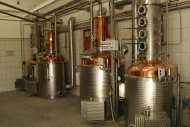Pay distillation/ commercial distillation
You find our settlement in outer area of Dunavecse 200 meters from the centre, surrounded by public utilities. Here’s our refrigerator, the drying house and distillery as well. The following technical review concerns only the distillery. Our home-distilled distillery is suitable both for pay distillation and commercial distillation.
 PAY DISTILLATION – we are at your service!
PAY DISTILLATION – we are at your service!
The process of pay distillation: receive the material, distil, deliver the finished product. Let us show you how a real Hungarikum is prepared!
- Receiving the material – expert knowledge for quality
We receive mash from our clients in covered plastic barrels, which always starts with quality examination in the presence of the customer, when the quality of the distillable fruit is determined by manual refractometer and survey. Pouring on follows the sampling. In case of mash the basic material of the prospective distillate directly gets into the 1500 litre receiving buffer containers before pump it into one of the stills through the closed piping. In case of grape-skin mash grinding comes first then comes the above-mentioned pouring on. Our customers may wash their mash containers then and there.
- Distillation – how do we produce the finest pálinka from your fruit?
Home-distillation is a closed technological process. In our distillery we have 2 pieces of 500 litres of useful volume, duplicated, water-jacketed, natural gas-heated stills plus the belonging production line. The still is a closed system supplied with a special pouring slot and head with vapour pipe, in which the mash begin to boil due to the heating. Here starts the airy ring dance of distilling. The developing humes get into the refrigerator through the stilted head and vapour pipe, and as a result of the applied refrigeration tail condensation takes place. Being purified through the filtering apparatus tail gets into the still of 250 litre where due to gas heating it starts boiling again. The developing fumes is condensed in every plate in the amplifier, reach the boiling heat on every switched on plate then through the refrigerator and vapour pipe it gets into the pipe bundled refrigerator where due to cooling it condensed again and become liquid. The condensed pálinka gets into the pálinka-collector tank through eprouvettes and the alcoholmeter.
- Handing over the finished product – Pálinka you can proudly show to your friends!
After measuring the condensed liquid– in the presence and with the participation of the customer – we drain the finished product into the condenser receiver then pour the pálinka into the customoer’s container. We developed our settlement’s delivery depot to be comfortably approached with freight car as well.
 COMMERCIAL DISTILLATION – Products of Vecse Komplex Kft.
COMMERCIAL DISTILLATION – Products of Vecse Komplex Kft.
In case of our own products we process fruits with more severe conditions. The process of commercial distillation starts with fruit-preparation then materials enter into the phase of mashing, distillation, aging, bottling and finally, sale. The capacity of our fruit processing line is 2 t/h. We usually process plum, apricot, apple and pear for pálinka. On the average, in case of apple or pear, we get 90 l of mash and 5 l of pálinka, in case of plum or apricot we get 92 l of mash and 6 l of pálinka out of 100 kg of fruit. Our fruit distillate on set alcohol content is aging in 3 pcs of 2 m3 stainless steel alcohol tanks and 8 pcs of gönci barrels. Our aging capacity is 7,3 m3. We continuously record maturation and qualitiy facts, details.
SECURITY AND ENVIRONMENTAL PROTECTION IN A XXI. CENTURY WORKPLACE
We care no to pollute our environment with any harmful substance all through the production process, and pay much attention to reuse most of the vegetal waste as well. After the distillation of raw materials we pump the malt returns into one of our 15 m3 mash-containers. After resting, diluting and setting pH level the malt returns is used up in tillage watering. The tail and subsequent alcohol, tail sewage (lutter water) is get into a sewer – later it will be destroyed.
We pay attention to our employees’ safety throughout the production as well – we settled alcohol sensors and emergency ventilation holes into the distillery in case of average.









